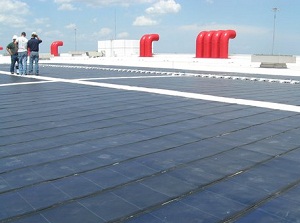Reviewing last week's solar energy news
 Labor Day’s passed, as have some hurricanes. Kids are back in school, and everyone’s returning to the hum-drum of work (hopefully). While solar had some choppy moments last week, overall it weathered a week of international market tumult well.
Labor Day’s passed, as have some hurricanes. Kids are back in school, and everyone’s returning to the hum-drum of work (hopefully). While solar had some choppy moments last week, overall it weathered a week of international market tumult well.
The darkest news for solar last week came with the announcement that Solyndra filed for bankruptcy. The company couldn’t bring costs down to compete with silicon photovoltaics, which have dropped significantly. It was the third U.S.-based solar company to do so in the past few weeks. It was also the first company to receive a loan-guarantee under the Department of Energy’s loan-guarantee program, and the loan-guarantee winner to file for bankruptcy.
The demise of Solyndra casts clouds over the DOE’s loan-guarantee program, which sunsets at the end of September. The DOE is still finalizing other loan guarantees. Most recently it finalized an $852 million loan guarantee for the 250-megawatt Genesis Solar Project in California. The project is a concentrated solar power system using solar troughs to super-heat water into steam and produce power via a conventional steam-turbine system.
While the federal government has been the largest investor in solar in the past few years, more private companies are joining in. For instance, last week Sol Systems launched the $350 million SolMarket. SolMarket was developed to help solar project developers find financiers through an online market place with extensive resources for both project developers and potential funders. Sol Systems expects the fund to grow to support more systems in the future.
When it comes to weathering the storm, it turns out that photovoltaics—at least rooftop photovoltaics—are up to the challenge. SunRun, a solar power service company, reported that few of its rooftop installations on homes in the Mid-Atlantic region up through Massachusetts, reported major damage to their rooftop systems in the wake of Hurricane Irene. One homeowner posted a video of his home’s solar array, before, during and after sustaining the 75-mile-an-hour winds of Irene, showing no damage to the array.
In a hurricane of activity, Florida Light & Power Co.’s (FPL’s) solar incentive program was reopened on Aug. 30, with $5 million in funds available. It was exhausted a couple hours later. It’s the second time the company’s offered homeowners solar incentives through the pilot program and shows how high the demand for solar is in the state.
In Hawaii, the Navy said it will spend up to $500 million to purchase solar power built on its facilities in the island state. The systems will be installed by third-party contractors, who will own, operate and maintain the systems.
In Vermont solar got a leg-up over the other most popular renewable energy, wind. Protesters took to the state lawn, asking the governor and the state to support solar projects over large-scale wind projects.
The solar industry remains an important economic driver for the U.S. A GTM Research report for the Solar Energy Industries Association (SEIA), found that in 2010, the U.S. exported nearly $2 billion more in solar goods in 2010. In all, the country exported a total of $5.6 billion in solar goods and imported $3.8 billion in solar goods.
First Solar (Nasdaq: FSLR) and General Electric Energy Financial Services, will build and help finance, respectively, the first large-scale solar farm in Australia. The 10-megawatt (AC) Greenough River Solar Farm is being jointly financed by the GE unit and Western Australia’s state-run Verve Energy.
Meanwhile Japan’s new renewable energy law could increase sales of photovoltaics across the world. The law goes into effect in July 2012 and will establish a new feed-in tariff for solar in Japan.
Image courtesy of NREL.



